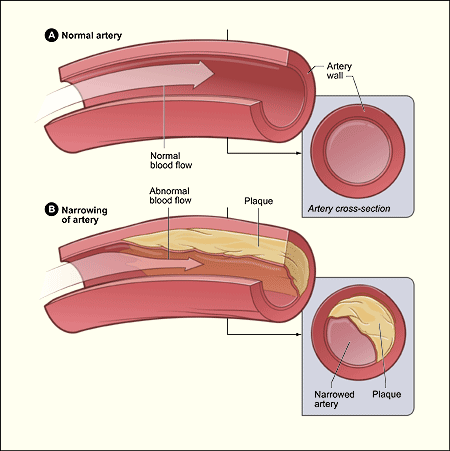What Is Coronary Artery Disease?
Coronary artery disease (CAD) is a condition in
which plaque (plak) builds up inside the coronary arteries. These arteries
supply your heart muscle with oxygen-rich blood.
Plaque is made up of fat, cholesterol
(ko-LES-ter-ol), calcium, and other substances found in the blood. When plaque
builds up in the arteries, the condition is called
atherosclerosis
(ATH-er-o-skler-O-sis).
Atherosclerosis

Figure A shows a normal artery with
normal blood flow. Figure B shows an artery with plaque buildup.
Plaque narrows the arteries and reduces blood flow
to your heart muscle. It also makes it more likely that blood clots will form
in your arteries. Blood clots can partially or completely block blood flow.
Overview
When your coronary arteries are narrowed or blocked,
oxygen-rich blood can't reach your heart muscle. This can cause
angina
(an-JI-nuh or AN-juh-nuh) or a
heart
attack.
Angina is chest pain or discomfort that occurs when
not enough oxygen-rich blood is flowing to an area of your heart muscle. Angina
may feel like pressure or squeezing in your chest. The pain also may occur in
your shoulders, arms, neck, jaw, or back.
A heart attack occurs when blood flow to an area of
your heart muscle is completely blocked. This prevents oxygen-rich blood from
reaching that area of heart muscle and causes it to die. Without quick
treatment, a heart attack can lead to serious problems and even death.
Over time, CAD can weaken the heart muscle and lead
to heart
failure and
arrhythmias
(ah-RITH-me-ahs). Heart failure is a condition in which your heart can't pump
enough blood throughout your body. Arrhythmias are problems with the speed or
rhythm of your heartbeat.
Outlook
CAD is the most common type of heart disease. It's
the leading cause of death in the United States for both men and women.
Lifestyle changes, medicines, and/or medical procedures can effectively prevent
or treat CAD in most people.
June 2008
|

